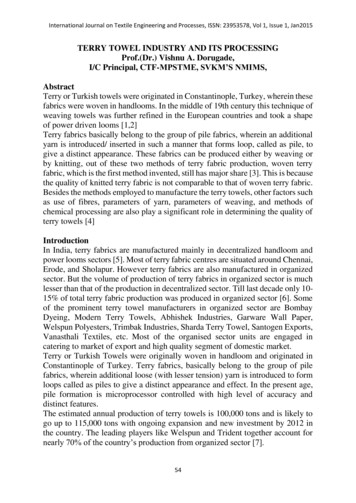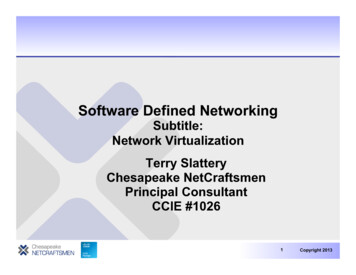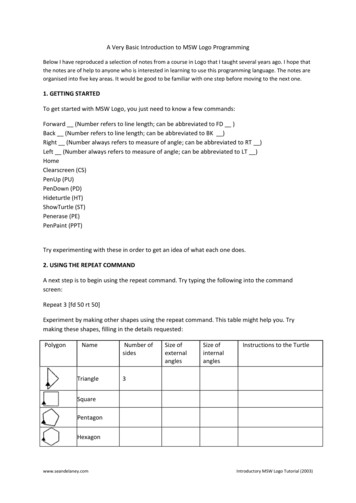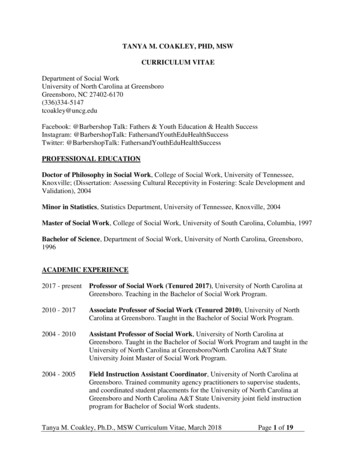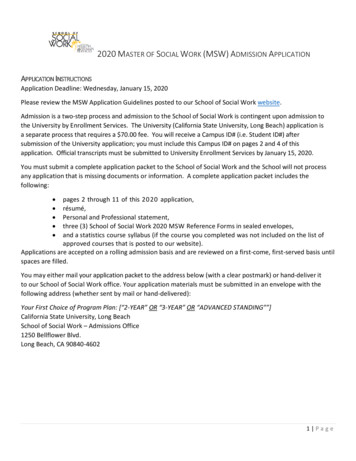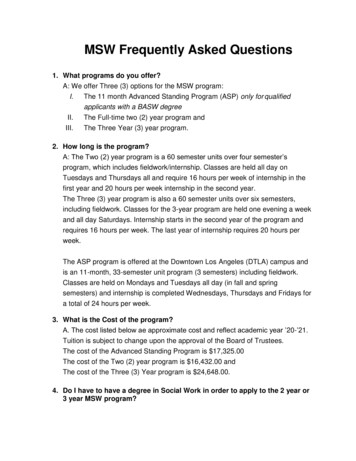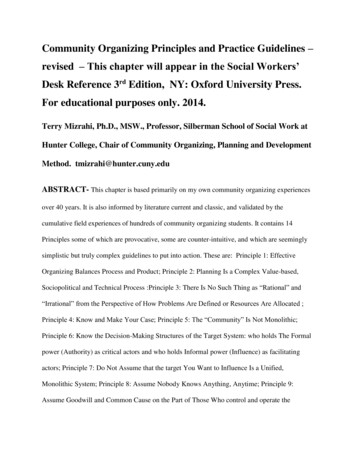
Transcription
Community Organizing Principles and Practice Guidelines –revised – This chapter will appear in the Social Workers’Desk Reference 3rd Edition, NY: Oxford University Press.For educational purposes only. 2014.Terry Mizrahi, Ph.D., MSW., Professor, Silberman School of Social Work atHunter College, Chair of Community Organizing, Planning and DevelopmentMethod. tmizrahi@hunter.cuny.eduABSTRACT- This chapter is based primarily on my own community organizing experiencesover 40 years. It is also informed by literature current and classic, and validated by thecumulative field experiences of hundreds of community organizing students. It contains 14Principles some of which are provocative, some are counter-intuitive, and which are seeminglysimplistic but truly complex guidelines to put into action. These are: Principle 1: EffectiveOrganizing Balances Process and Product; Principle 2: Planning Is a Complex Value-based,Sociopolitical and Technical Process :Principle 3: There Is No Such Thing as “Rational” and“Irrational” from the Perspective of How Problems Are Defined or Resources Are Allocated ;Principle 4: Know and Make Your Case; Principle 5: The “Community” Is Not Monolithic;Principle 6: Know the Decision-Making Structures of the Target System: who holds The Formalpower (Authority) as critical actors and who holds Informal power (Influence) as facilitatingactors; Principle 7: Do Not Assume that the target You Want to Influence Is a Unified,Monolithic System; Principle 8: Assume Nobody Knows Anything, Anytime; Principle 9:Assume Goodwill and Common Cause on the Part of Those Who control and operate the
System; Principle 10: Assume the Principle of Least Contest. Escalate the Process Only asNeeded; Principle 11: There Will Always Be Opposition to Change at Some Level, Be it Activeor Passive Resistance; Principle 12: in Making Change from the Inside, Assess RisksRealistically—Identify and Weigh Costs against Gains; Principle 13: Recordkeeping andNoteTaking are Political, not Clerical Functions; Principle 14: The Media Are Unpredictable andA-moral. Proceed with Caution.This chapter is based primarily on my own experiences over 40 years. It is also informed by theliterature reflected at the end, and validated by the cumulative field experiences of hundreds ofcommunity organizing students at the Silberman School of Social Work at Hunter College(formerly Hunter College SSW). I address the reader as “you” and assume that you are readingthis when you initiate or are being called on as a student or experienced organizer to respond toan issue, address an agency or community need or are training and teaching others theseprinciples. The phrase “target of change” is used to mean whichever body (a person, agency, or asystem) you are trying to influence. These principles are not laid out in a linear order. Several ofthem need simultaneous consideration before taking action; others are interactive and overlap.PRINCIPLE 1: EFFECTIVE ORGANIZING BALANCESPROCESS AND PRODUCTA key assumption is that there is never sufficient time, staff, and other resources to involve peoplein making change (the process) and accomplishing a specific goal or task (the product). Both areimportant, so the question is how to operationalize and balance them. Process means that theremust be enough discussion to achieve a consensus to move ahead and keep the participantsengaged. This does not mean unanimity, but rather a “sense of the body,” informally or formally
(by vote) determined. Where there is disagreement, there must be a mechanism to ascertain itsintensity, and whether moving ahead means a permanent division or dissolution. How muchdissention is inevitable and acceptable? You need enough process to gauge people’s interest inand commitment to the task. Involvement of people creates a sense of investment and canultimately lead to a sense of ownership of the product as well as a transformative process ofworking together in its own right. You need time to build trust between the group and you as well asamong participants. That can be done by working on the task while reflecting periodically on theprocess: “How we are doing?” “Whose voices do we still need to hear from?”The solutions to managing time so that you achieve the product without sacrificing theprocess are to (a) calculate a more complete and realistic timetable; (b) modify expectations ifnecessary; (c) prioritize what is essential with those involved; and (d) ascertain who else can assistwith the project. Organizing means planning for contingencies, allowing more time than appearsnecessary, following through and paying attention to detail.PRINCIPLE 2: PLANNING IS A COMPLEX VALUEBASED, SOCIOPOLITICAL AND TECHNICAL PROCESSPlanning is not just about data collection, goals, and timelines or who can write a clear, internallyconsistent proposal. Rather, planning, as a part of organizing is a sociopolitical as well as atechnical process. Power and resources inform the way you and your constituency define theproblem and select the solutions. But underlying planning is a value base or ideology whichincludes basic assumptions about why a problem exists, why needs are not being met, whyconditions are not optimal, and ascertaining who or what is to “blame” for the problems identified.Social work values are informed by social and economic justice and democratic, participatorydecision-making. Power means understanding that somebody (with a small or capital B), that is,
some individual or group has the ability to make decisions about how resources are allocated andwhether to implement the program or change a policy. Resources include creating, increasing orredistributing assets (social and economic capital) that address the planning outcomes. Hence,the strategies you select for influencing the decision makers to achieve your goal are done withina social-political and value based context.Here are some examples, substance abuse was identified as a national problem in the1960s when it spread beyond the ghetto to middle-class America; mental retardation “came out ofthe closet” when President John F. Kennedy disclosed that he had a mentally retarded sister.While middle-class parents had been organizing and planning services for their childrenthroughout the 1950s, mental retardation became a national priority because the president used hisoffice to create funding opportunities for additional facilities and programs. On the other hand,HIV/AIDS did not become a national priority when first detected because President RonaldReagan did not publicly address the problem until enough visibility and pressure was placed athis doorstep in 1986. It took organized social action of groups like ACT-UP together withpublicity about a Caucasian boy Ryan White who contracted AIDS because of a bloodtransfusion that led to additional funding for prevention, education, and treatment with theinvolvement of consumers and providers.PRINCIPLE 3: THERE IS NO SUCH THING AS “RATIONAL”AND “IRRATIONAL” FROM THE PERSPECTIVE OF HOWPROBLEMS ARE DEFINED OR RESOURCES ALLOCATEDMany times as part of the process of identifying problems, someone may say that aparticular system or structure or policy needs to be changed because it doesn’t make sense; “It’sirrational.” When someone makes such a statement, consider reframing the question by asking that
person or group instead: “To whom does it make sense?” “For whom is it functional andworking?” “Why hasn’t that policy been changed, if it isn’t working for your constituency?” Youwill usually uncover reasons why conditions or attitudes have remained in place, why a needwasn’t met, why people have resisted change, or why a new program wasn’t implemented.Usually the case does make sense from the perspective of those who maintain that system oroppose the change. It is essential to consider reasons for the resistance to change. For example, anew program can be an implied criticism of the existing system. It may mean that a groupperceives they will lose power if that program is created. In other words, it’s not irrational forgroups that may be affected adversely to attempt to maintain the status quo. Understanding thisallows you to identify the covert as well as overt reasons for resisting change and developstrategies to decrease resistance. This does not mean that there aren’t instances where situationsdon’t change because of mistakes, arbitrariness, inertia, time or cultural lag, or misinformation.Not everything is deliberate and conscious. Analyzing the status quo which seems irrational canbe done by “peeling the onion,” addressing the stated reasons one at a time until perhaps theunderlying rationale, whether coherent or not, becomes evident.Understanding that there is no such thing as value-free planning and organizing providesan opportunity to identify and explore the values and beliefs that inform the problem definition,which in turn shapes the proposed solutions that emanate from that definition. It allows you tounderstand why your group’s beliefs and proposals may be seen as irrational to others.It is important to understand that “rationality,” when it means utilitarian, is itself anideology, one that is usually associated with capitalism and pragmatism. Often the term“rationality” is invoked to contrast it with “ideology,” as opponents of a plan will state that theproposers are not being rational. You need to consider whether evoking “rational” solutions is
being used to prevent deliberations that include values such as fairness, equality, and justice, or ifit is being used to divert or discredit those who have a progressive value base. Nevertheless, youneed to be open to listening to opposing viewpoints and understand and explain their attitudesand behaviors without necessarily excusing or exonerating their conclusions. To take theexample of homelessness, the problem was ignored by government and the public until acombination of deinstitutionalization of mental hospitals and gentrification of formerly abandonedand neglected neighborhoods resulted in hundreds of thousands of people without a place to livein the 1970s. However, the solutions to homelessness are informed by values and ideology, notjust on the basis of need or data alone. Those who perceived it as a housing problem advocatedfor the right to shelter and housing; those who perceived it as a mental health problem advocatedfor services; those who perceived it as a civil liberties problem advocated for personal choice andthe right to be left alone; and those who perceived it as a criminal justice and morality problemadvocated for incarceration, involuntary commitment, forced work, and other social controlmeasures. These were all “rational” solutions from the perspective of the proposers.Nevertheless, political and ideological arguments about rationality should not obfuscateyour need to be logical, systematic, and problem-focused. It is necessary to anticipate the steps,activities, people, and resources needed to produce a coherent plan from beginning to end,implement it, and evaluate it, and also to identify contingencies beyond your own and yourconstituency’s control. Analytical skills as part of “rational” planning are essential.PRINCIPLE 4: KNOW AND MAKE YOUR CASEAssessments are a critical part of community organizing and planning practice. It isessential to ask the question: “How do you know there is a problem?” “How do you know there
is a need for a particular intervention?” “Who asserts that there is a problem/need?” “Who isdefining the problem/need? Why at this time?” “How serious and pervasive is the problem?As noted in principles 2 and 3, defining the need has an ideological as well as factualcomponent. For example, if it is reported that 30 percent of the students in a particular school orcommunity did not complete high school, the questions to be posed should include: “Is that aproblem?” “For whom is that a problem?” “What are the solutions?” Answers to those questionswill depend on several factors and values: whether the norm in that community (howeverdefined) is to complete high school, whether it is desirable to complete high school, whether thatfigure has gone up or down in the last several years, how that figure compares to other schools,and the alternatives to and consequences of not completing high school. Remember, the way aproblem is defined will determine the proposed solution(s). If you report that 30 percent of thestudents dropped out of school last year, there is already an implied causation. “Drop out”implies a willful act on the part of the student or neglect on the part of parents or the community.Consider the difference when you say that 30 percent of the students were “pushed out” or “turnedout” last year. The latter implies the problem lies primarily with the school system.Once you define the problem, the next step in the planning process is to document theproblem. This entails gathering quantitative and qualitative data, sometimes called empirical(objective) and perceptual (subjective) information. The needs assessments that use both aremost effective; they present statistics as well as humanize the issue. Documentation includesidentifying assets and deficits. Prepare the materials using multi-methods and media-- in writing,verbally, and visually. In making your case use numbers, narration, surveys, interviews, casestudies, anecdotes, and secondary data analysis. Language matters. How one phrases a term alsoaffects how it is received; e.g. when homeless people are welcomed as “guests” rather than
identified as “the homeless;” it makes a difference. Calling someone an ex-con versus a formerlyincarcerated person, makes a difference in how the message is perceived.Next, consider the ways to convey that information to make the strongest, mostconvincing case. First you need to identify the various audiences who need to know about theproblem. How do you reach the different communities and constituencies? How do they bestreceive information? Communicating with the decision makers may be different fromcommunicating with supporters and allies. To reach the public at large, you may need differentmeans and messages from the ones used for reaching clients and constituencies. Here are just afew of the many steps to consider: Will it be in the form of a letter or a report or an article in acommunity newspaper or a story on an ethnic radio station? Who writes and signs it? Who willreview the format and content? Remember, presentation is as important as the content. Pithy andpoignant are key words in persuasive communication. Make it brief with emotion! Lengthierbackground information pieces should be available without inundating the various publics. Isthere a public or private forum where the data should be presented? Who will be there? Who elseshould be invited or know about the event? What materials should be presented (e.g., fact sheets,photos or videos of the conditions, testimonies of people directly affected, experts and influentialpeople in the field)? Who will follow up? Outreach is a strategic campaign of many steps, notjust an activity.For example, several years ago, a director of a public health clinic helped createadditional funding for dentistry for low-income adults by making the case about the depth andbreadth of the problem. He launched a public awareness campaign showing enlarged photographsof decayed mouths of adults. He took them to many public forums in that community and then tothe press. When asked the age and country of the people with this severe dental disease, no one
could guess that they were New York City residents 20 to 40 years old. This created publicsentiment for increasing coverage of preventive dental care for low-income populationscommunicated to the decision-makers, the City Council and the Mayor.PRINCIPLE 5: THE “COMMUNITY” IS NOT MONOLITHICIn engaging in a change effort or trying to build the influence of your constituency, the organizermust pay attention to historic tensions, intra- and interpersonal conflicts and inter-organizationaland inter-disciplinary differences as well as structural inequalities that prevent people fromworking together. Community has multiple definitions (geographic, symbolic, identity,interest/issue-based). The tension is that for some political and strategic purposes it is importantto identify a general constituency (e.g. Latinas, seniors, Asian-Americans); for other purposes, itis important and almost inevitable to recognize that within that large category there usually aredifferences by other identities such a gender, country of origin, culture and other attributes whichcan divide the group if unaddressed. Organizers must balance unity and diversity.If the aim of organizing is to build a diverse constituency or coalition that ismulticultural or includes segments of a community that have been excluded, additional time andthoughtfulness must be brought to the fore. Historic and current differences by class, race,gender, ethnicity, status, or sexual orientation have to be factored in from the beginning.Experience has shown the difficulty of including excluded groups after a process of building anorganization or coalition has begun. Consider the groundwork that has to be done “on the way tothe first meeting.” Acknowledge and anticipate heightened sensitivities if new partners fromdifferent backgrounds are coming together for the first time, or if groups that distrust each otherare returning to a new table.
The relationship between an organization that is leading a campaign (whether at agrassroots or coalition level) and the constituencies it wishes to reach are the important factors. Isthe organization trustworthy? Is there a track record of competency? As you begin outreach, thereputation of your organization counts. Are the organization and organizer from that community(however defined) or from outside? The organizer is not a free agent. The auspice and backgroundof the organizer is critical in the role he/she plays in organizing a campaign.There are benefits and limitations to both the insider and outsider position. An insideorganization has a track record and already has its allies and (most likely also) detractors; anoutside organization (e.g., a university, a foundation, a corporation) especially if it is mainstreamand powerful, may or may not have a positive track record with that community. A person withthe same identity (or one or more identities—e.g. gender, race, education) as the constituencymay be accepted more easily, but an outside person with a different background may bring newideas, connections, a fresh perspective and may be able to bridge internal divisions.PRINCIPLE 6: KNOW THE DECISION-MAKINGSTRUCTURES OF THE TARGET SYSTEM: WHO HOLDSFORMAL POWER (AUTHORITY) AS CRITICAL ACTORS ANDWHO HOLDS INFORMAL POWER (INFLUENCE) ASFACILITATING ACTORSUnderstanding and utilizing the concept of power; which body (person) or Body (group, structure)can make the change you want is an essential organizing component. It is important to analyze thetwo faces of power—authority and influence. The “critical” actors are the actual legitimatedecision makers, those with the sanctioned formal authority to grant the request, make the change,and allocate the resources. The facilitating actors are those who can influence the critical actors
because of their relationship to them. Many times, people don’t know who has the formal powerbecause it is hidden, or because the system is complicated. The best approach is to do a poweranalysis beforehand. Who are the people and organizations who control the systems you want toinfluence? For example, the authority in a hospital may be vested in the board of trustees and themedical boards. State health departments have the authority to grant or suspend an operatinglicense to that hospital, has the ultimate formal power over the hospital—although they may notreadily use it. The authority to evict a te
Terry Mizrahi, Ph.D., MSW., Professor, Silberman School of Social Work at Hunter College, Chair of Community Organizing, Planning and Development Method. tmizrahi@hunter.cuny.edu ABSTRACT-This chapter is based primarily on my own
